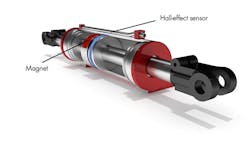This file type includes high-resolution graphics and schematics when applicable.
Francois Gabart, a French champion of solo offshore sailing, completed his first solo win on board his new 100-ft. trimaran, MACIF, when he crossed the finish line of The Transat bakerly off New York in the Ultime class category. In 2013, Gabart became the youngest-ever winner of the Vendée Globe solo round-the-world race, covering an official distance of 3,050 nautical miles in 8 days, 8 hours, 54 minutes and 39 seconds.
The MACIF, capable of sustained speeds of 40 knots, measures 21 m across, weighs 14.5 tonnes, and has sail areas of 430/650 m2. Its huge rotating wingmast can be canted to windward to generate more power while reducing the downward force on the leeward float. The boat also has a retractable V-shaped foil in each float, and the pitch can be manually adjusted.
MACIF represents a departure in how these multi-hulled vessels are being sailed, with both steering positions inside a cabin. This area looks something like a ship’s bridge. Behind that is a “cuddy cabin” on the same level, which houses a bunk, seat, and navigation area. The MACIF represents the state of the art in ocean-sailing technology, with rigid carbon-fiber hulls and curved dagger boards that are designed to generate lift to raise the boat out of the water and reduce friction.
Manually Powered Hydraulics
Much of the boat’s control is powered from the manually driven pumps—called grinders—that transmit hydraulic power for several of hydraulic cylinders that move the foils, mast, dagger board, and steering. Some of the cylinders contain position sensors, which transmit position information to displays back in the cabin. Although the position feedback signal does not provide any control, it lets Gabart monitor the position of the mast and dagger board without having to leave the cabin, which is especially valuable in poor weather.
Gabart says boat and sail designs are fairly mature at this point, but he believes electronics are going to be much more important in ocean racing. His role as a lone skipper is increasingly like that of a pilot on a fully automated airliner: Instead of steering the boat, he monitors the systems and tries to optimize performance to squeeze an extra knot or two of speed out of the given conditions.
The hydraulic-cylinder position feedback signals are generated by Hall-effect linear transducers from Rota Engineering. The firm’s linear transducers are usually installed inside a cylinder by boring into the center of the cylinder’s piston rod. This setup provides a compact assembly and protects the sensor inside the cylinder’s relatively secure environment. However, with the MACIF, the transducers’ sensing elements mount onto the OD of the cylinder tube.
A small magnet embedded in the piston transmits a position signal to the sensing element through the cylinder wall. This ensures no reduction in piston-rod buckling strength and allows for easy installation and replacement without having to remove the cylinder.
Hall-effect transducers use a well-proven technology offering non-contact operation with analog or digital output in a compact, weather- and pressure-proof housing featuring resolution to 0.1 mm. The external mounting is also possible with carbon-steel cylinders with wall thicknesses of up to 12 mm. Moreover, the transducers are highly resistant to high shock and vibration.





